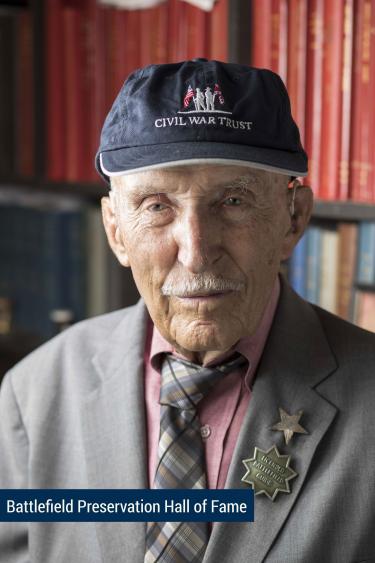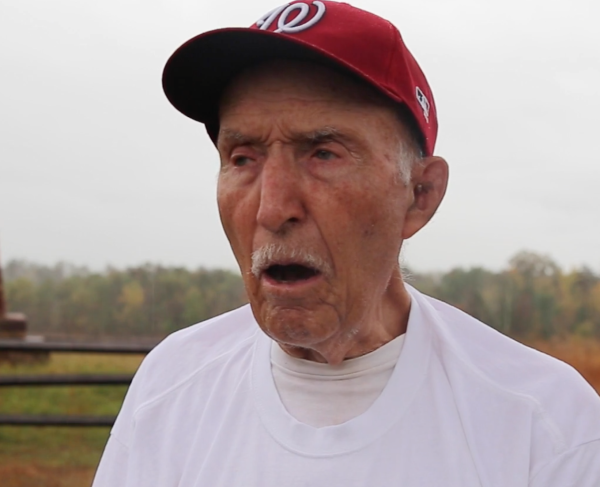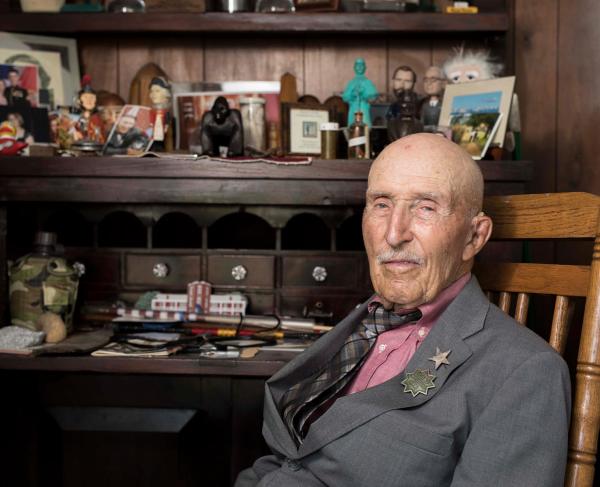Edwin C. Bearss: Historian, Veteran, and Trustee

Leaving behind an insurmountable legend in the history and preservation community, Edwin Cole Bearss passed away on September 15, 2020, peacefully and surrounded by family, at the age of 97. Although a prolific author on topics in military history, Bearss was particularly dedicated to the importance of preserved landscapes to enhance our understanding of the past. He was among the originators of the modern battlefield preservation movement and a devoted tour guide, travelling up to 200 days per year into his 90s. He was an early board member of the Civil War Trust, a predecessor organization of the American Battlefield Trust, and served on our board until his passing in the capacity of historian emeritus.
Bearss was born in Billings, Montana, on June 26, 1923. He grew up on his grandfather's ranch near Hardin, Montana, in the shadow of the Rosebud Mountains within a bike ride of the Little Bighorn Battlefield. On the ranch, the E Bar S (E-S), he named the cattle for Civil War generals and battles. His favorite milk cow was Antietam.
Bearss attended a one-room school at Sarpy, Montana, until he went to St. Johns Military Academy in Delafield, Wisconsin, in 1937. After graduating from Hardin High School in 1941, he spent the summer hitchhiking across the country to visit battlefields. Bearss returned home and, after the Japanese bombed Pearl Harbor, followed in the footsteps of his father and Medal of Honor–recipient older cousin to enlist in the U.S. Marine Corps. During World War II, he was with the 3rd Marine Raider Battalion and 1st Marine Division in the invasion of Guadalcanal and New Britain. Badly wounded by machine gun fire during the 1944 Battle of Suicide Creek, he spent 26 months in various hospitals. His injuries limited his dexterity for the remainder of his life.
Bearss studied at Georgetown University and received a B.S. degree in Foreign Service in 1949. He worked for 3 years in the Navy Hydrographic Office in Suitland, Maryland. Later, at Indiana University, he received his M.A. in history, writing his thesis on Confederate Maj. Gen. Patrick Cleburne.
His National Park Service career began in 1955 at Vicksburg, Mississippi, where he was Park Historian. While there, he did the research that led him and two friends to the long lost resting place of the Union gunboat Cairo. He also located two forgotten forts at Grand Gulf, Mississippi and helped transform Grand Gulf into a Mississippi State Military Monument. He was the founder of the Mississippi Civil War Round Table in 1956, which later consolidated with the Jackson Civil War Round Table.
In 1966, Bearss was transferred to Washington, DC. He became the National Park Service's Chief Historian in November 1981, a position he held until July 1994. He served as the Director's Special Assistant for Military Sites until his retirement on October 1, 1995. Upon retirement, Bearss, through lectures, television, writing, and as a renowned battlefield guide, continued his 50-year association with our nation's military history.
Bearss was the recipient of a number of awards in the field of history and preservation: the T. Harry Williams Award; the Bruce Catton Award; the Alvin Calman Award; the Bell I. Wiley Award and others. He was chosen Man of the Year at Vicksburg in 1963. He received the Harry S Truman Award for Meritorious Service in the field of Civil War History. In 1964 he was chosen to become a member of the Company of Military Historians and was voted a Fellow in that organization. In 1983, he won the Department of the Interior's Distinguished Service Award, the highest award given by the department. He received a commendation from the Secretary of the Army in 1985, as he was a veteran of 50 years of Government Service. The Trust also named its lifetime achievement award in his honor and dedicated a monument to his achievements on Champion Hill Battlefield in Mississippi.
He did detailed studies for the National Park Service for many areas: Vicksburg; Pea Ridge; Wilson's Creek; the Ray House; Fort Smith; Stones River; Fort Donelson; Battles around Richmond; Bighorn Canyon; Eisenhower Farm; the gold miners' route over Chilkoot Pass; LBJ Ranch; Fort Moultrie; Fort Point; Wiliam Howard Taft House; Fort Hancock; Boston Navy Yard; Herbert Hoover National Historic Site and others.
Bearss was a regular guest on programs for the History Channel, A&E Networks and TLC, as well as multiple appearances throughout Ken Burns’s 1990 iconic documentary The Civil War.



